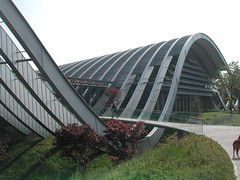Zentrum Paul Klee

DSCN9949.JPG
Originally uploaded by scisar.
Last Thursday I had to go to Berne and since I was already there I went to see the new Zentrum Paul Klee, which has a 4000 piece strong collection of paintings, aquarelles, drawings and biographic material on Paul Klee. The center combined public (from the Art Museum of Berne) and private collections to the most important on Klee. The building was designed by Renzo Piano and was inaugurated this summer. The building emerges from the glacial shaped hills of the "espace mittelland" sourrounding Berne and form a structural skeleton of beams that resemble a wave or a moraine.
The detailing is as usual, or at least like at the Fondation Beyeler, which was also designed by Piano, very precise executed and stunning in it's features. He multiplied the highway and added a string of public walkway outside and one inside the building. The latter forms the "Museums Weg" (street), which is a public connection/corridor between the three main buildings. This corridor disembogues in each building into a public foyer, which host the ticketing and café area, the museum-shop, an exhibit on the building's architecture and the entrances to the exhibits and additional program, such as auditorium, archives and a research library.
The column-free space, that the skeleton creates hosts in the middle building the main exhibit, inside it's belly. The paintings and drawings are hung on cardboard walls, approximately 2.5 meters high, that orginse and break the large hall down into more intimate spaces. Cotton-fabrics hung down from above enhance the intimacy. The gaps between the beams mostly host windows, shich again are covered by fabrics to dim and disperse the light, since the Klee's work is very light sensitive and therefore need controlled lighting.
You could argue that for the latter fact it was usefull hiding the building below ground, at least parts of it, but the potentially very lighty lit exhibit space needs additionally darkening if you like. But since the exhibited works could be rearanged and the walls removed completely, the curator got an additional multifunctional room, which surely helps the museum's flexibility. The public space with the free areas have the only real façade of the building, facing towards west, and they feel generous layed out and spaced, although I got a slight feeling of a typical european trainstation because of how the façade looks like from the inside (the huge glassfront in a shape of a half-ellipse).
Overall surely a very nice addition to the museum-landscape of the city of Berne and Switzerland. Architecturally certainly interesting, although I don't agree on certain issues (the form forced certain compromises in my opinion but that's a whole other discussion).
If the buidling is worth it's 110 Mio sFr.? I suppose, otherwise it most probably wouldn't have been built. But let's not forget the collection which it hosts, is remarkable and absolutely worth a trip to Berne.
-s


A
ReplyDelete